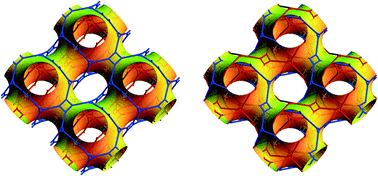Some equivalent two-dimensional weavings at the molecular scale in 2D and 3D metal–organic frameworks
Abstract
Metal–organic frameworks (MOFs) are often comprised of multiple disjoint molecular networks. The catenated loops and tangles of these patterns typically defy simple enumeration and explanation. Here we contrast some planar layer MOFs (built of (4,4) layers) with the three-dimensional crystals MOF-14, MOF-388 and UTSA-28. The analysis allows planar weavings to be warped, giving analogous three-dimensional frameworks. The technique allows us to warp the most common (4,4) layer MOFs. The resulting three-dimensional weavings are those of MOF-14, MOF-388 and UTSA-28. So two- and three-dimensional MOFs are weavings of layered nets. In the former case, the layers are conventional flat sheets, in the latter they are hyperbolically curved layers. This recognition suggests a simple enumeration scheme for generating and cataloguing MOF weavings via two-dimensional surfaces, regardless of their apparent dimensionality.


 Please wait while we load your content...
Please wait while we load your content...